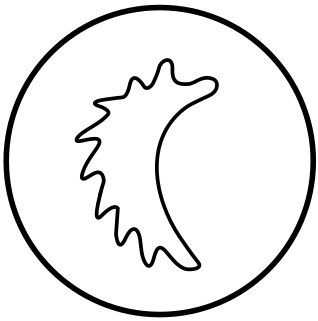The 164th Infantry Division was an infantry division of the German Army during World War II. Formed in November 1939, the division took part in the invasion of Greece in April 1941. In January 1942, consolidating the Axis seizure of the island during the Battle of Crete, the 164th was reorganized as Fortress Division Kreta (FDK). In mid-1942 the division was transferred to North Africa and re-designated as 164th Light Afrika Division. It surrendered in May 1943 in Tunisia at the end of the North African Campaign.
The 9th Luftwaffe Field Division was an infantry division of the Luftwaffe branch of the Wehrmacht that fought in World War II. It was formed using surplus ground crew of the Luftwaffe and served on the Eastern Front from late 1942 to June 1944. It was badly mauled during the Soviet offensive of January 1944 near Leningrad. It was later merged with the 225th Infantry Division.
The 4th Luftwaffe Field Division was an infantry division of the Luftwaffe branch of the Wehrmacht that fought in World War II. It was formed using surplus ground crew of the Luftwaffe and served on the Eastern Front from late 1942 to June 1944 when it was destroyed during Operation Bagration.
The 6th Luftwaffe Field Division was an infantry division of the Luftwaffe branch of the Wehrmacht that fought in World War II. It was formed using surplus ground crew of the Luftwaffe and served on the Eastern Front from late 1942 to June 1944 when it was destroyed during Operation Bagration.

The 87th Infantry Division was an infantry division of the German Army during the Second World War, active from 1939 to 1945.

The 14th Panzer Division was an armoured division in the German Army during World War II. It was created in 1940 by the conversion of the 4th Infantry Division.
The 3rd Luftwaffe Field Division was an infantry division of the Luftwaffe branch of the Wehrmacht that fought in World War II. It was formed using surplus ground crew of the Luftwaffe and served on the Eastern Front from late 1942 to early 1944 at which time it was disbanded.
Vollrath Lübbe was a German general in the Wehrmacht. A veteran of World War I, he rose to command several divisions during World War II. He was a recipient of the Knight's Cross of the Iron Cross, awarded by Nazi Germany to recognise successful military leadership.

The 38th Infantry Division was a German Army infantry division in World War II. Formed in July 1942, it existed for a little over 15 months before being effectively destroyed in fighting on the Eastern Front in November 1943.

The 39th Infantry Division was a German Army infantry division in World War II. Formed in July 1942, it existed for a little over 15 months. Reduced to battle group size by October 1943 in fighting during the Battle of the Dnieper on the Eastern Front, it was disbanded in November 1943. Its surviving troops were absorbed by other German army formations.
The 1st Luftwaffe Field Division was an infantry division of the Luftwaffe branch of the Wehrmacht that fought in World War II. It was formed using surplus ground crew of the Luftwaffe and served on the Eastern Front from late 1942 to early 1944 at which time it was disbanded.
The 361st Infantry Division was an infantry division of the German Army during the Second World War, active from 1943 to 1945. It was redesignated as a Volksgrenadier division in 1944. It saw active service on the Eastern Front when the Soviets launched Operation Bagration, during which it suffered significant losses. It later fought in France before being absorbed by the 559th Volksgrenadier Division on 10 March 1945.
The 362nd Infantry Division was an infantry division of the German Army during the Second World War, active from 1943 to 1945. Formed in Italy, it participated in the Italian Campaign for the entire duration of its war service. It was implicated in the massacre of 97 civilians in what is known as the Benedicta massacre, which occurred at Piedmont in April 1944.
The 335th Infantry Division was an infantry division of the German Army during the Second World War, active from 1940 to 1944. It saw active service in France and on the Eastern Front and was destroyed in fighting in Romania in August 1944.
The 336th Infantry Division was an infantry division of the German Army during the Second World War, active from 1940 to 1944. It saw active service in France and on the Eastern Front. Largely destroyed during the Crimean Offensive, it surrendered to the Soviets at Sevastopol in May 1944.
Johann Joachim Stever was a German officer in the Heer branch of the Wehrmacht during World War II who also served in the army of Imperial Germany during World War I. During World War II, he commanded the 4th Panzer Division for a period of time in 1940. He later commanded the 336th Infantry Division and was then a military area commander in occupied Russia. Promoted to generalleutnant in 1941, he retired from active duty in 1944. He fell into Soviet custody as they advanced into Germany in 1945 and, having not been seen since, is believed to have died.
The 347th Infantry Division was an infantry division of the German Army during the Second World War, active from 1942 to 1945. Initially based in the Netherlands, it saw active service on the Western Front and was redesignated as a Volksgrenadier division in May 1945.

The 387th Infantry Division was an infantry division of the German Army during the Second World War, active from 1942 to 1944. It saw active service on the Eastern Front and was destroyed in fighting in Romania in August 1944.
The 5th Luftwaffe Field Division was an infantry division of the Luftwaffe branch of the Wehrmacht that fought in World War II. It was formed using surplus Luftwaffe ground crew and served on the Eastern Front from late 1942 to mid 1944, when was disbanded.

The 376th Infantry Division was an infantry division of the German Army during World War II, active from 1942 to 1944 in two separate instances.





